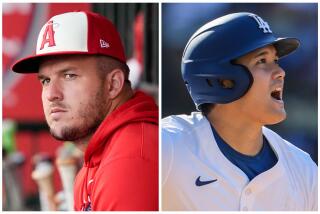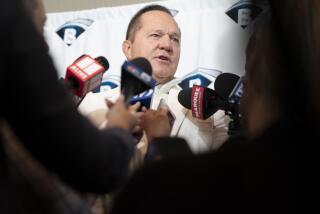With Giambi, Yankees May Be Back in Charge
Unless an editor files a contraction grievance, I’ll reduce my 2002 preview to a top 10 as the season opens in Anaheim tonight with the revived Angels trying to provide an answer for Mo Vaughn’s recent query, “What have they ever won?”
1. New York Yankees: Jason Giambi was simply trying to show he knows his place in the Bronx. “This is still Derek Jeter’s team,” said the former Oakland A’s leader, catching George Steinbrenner’s attention. Responded the Boss: “Jason was trying to say the right thing, but I would remind him that it’s still my team.”
2. Seattle Mariners: On the Far West team with the Far East flavor, ex-Angel Shigetoshi Hasegawa has joined Ichiro Suzuki and Kazuhiro Sasaki, but Lou Piniella still speaks only one language. Said the manager of a team that has won 207 regular-season games but fallen short in each of the last two Septembers: “It’ll be a disappointment if we don’t reach the World Series. We eventually have to break that door down.”
3. St. Louis Cardinals: Jason Isringhausen provides the much-needed closer, and Tino Martinez brings a clutch bat and the Yankees’ winning mentality as the replacement for Mark McGwire. It’s not an easy assignment, despite McGwire’s frequent absences the last two seasons. Wracked by injuries, McGwire still hit 61 homers in 535 at-bats, or one every 8.8 at-bats.
4. Arizona Diamondbacks: Randy Johnson and Curt Schilling were a combined 43-12 last year, dominating the West. The rest of the rotation remains tenuous, but all Johnson and Schilling may require again--like Spahn and Sain in another era--is a little rain and reliable relief from closer Byung-Hyun Kim, who will have to prove he has shaken his World Series trauma.
5. Atlanta Braves: With Greg Maddux and Tom Glavine in the last years of their contracts, and Gary Sheffield having-- temporarily at least--found peace, this may be a final chance for the Braves to convert their division dominance (10 titles in 11 years) into a second World Series crown. It also may be worth clipping and saving this appraisal of Sheffield by General Manager John Schuerholz as the Braves closed their spring camp: “The expectations we had about his ability and his impact on our team, the likelihood of his fitting in here and being comfortable here, have all come true, at this stage.”
6. Houston Astros: The Astros, Cardinals and Chicago Cubs may stage a dogfight in the NL Central, and maybe the Astros and Cardinals should be reversed in these rankings. The Astros boast the best young pitching East of Oakland, will start two rookies-- shortstop Adam Everett and third baseman Morgan Ensberg from USC--on the left side of their infield and seem to have responded to Manager Jimy Williams, who takes over a mutinous clubhouse from Larry Dierker after proving during a tumultuous Red Sox summer he can keep a team focused on the field.
7. New York Mets: A projected rotation of Al Leiter, Pedro Astacio, Shawn Estes, Steve Trachsel and Jeff D’Amico was 41-50 last year, the only reason the Mets are ranked this low and behind the NL East-rival Braves. Then again, each of the five pitchers experienced arm trouble last year, and all they really need to provide now are consistent innings, given the additions of Vaughn, Roberto Alomar, Roger Cedeno and Jeromy Burnitz to a potent lineup.
8. Oakland Athletics: The A’s retain a core of talented young position players and a dominant big three of pitchers Tim Hudson, Barry Zito and Mark Mulder, but you don’t take a most valuable player of Giambi’s stature out of the middle of the lineup--and clubhouse--or lose a catalytic leadoff man like Johnny Damon without consequences. Closer Billy Koch may fill the Isringhausen void, but it’s doubtful that David Justice and whoever the first baseman is--Carlos Pena? Scott Hatteberg?--can compensate for the offensive loss. As third baseman Eric Chavez noted, “Jason is gone. He can’t carry the team anymore. One of us has to step up.”
9. Boston Red Sox: There are new owners, handpicked by Commissioner Bud Selig. There are a new general manager, new manager, new center fielder (Damon), new first baseman (Tony Clark) and new reserve outfielder with the familiar name of Rickey Henderson. But unless Pedro Martinez has a new shoulder, the new Red Sox seem destined for their old role of chasing the Yankees. At least, with Carl Everett gone and Dan Duquette removed as general manager, they should do it more pleasantly.
10. Chicago White Sox: They are poised to replace the rebuilding Cleveland Indians as the dominant team in the AL Central. The acquisition of explosive leadoff man Kenny Lofton and a sound Frank Thomas figure to enhance a productive lineup. There is uncertainty, however, regarding the pitching and defense, both of which were so bad during spring training that General Manager Ken Williams often left his seat to remove stress on the treadmill. “It drives me nuts,” he said.
*
Wild West?
Despite baseball’s labor ills, there is a legitimate sense of competitive parity--as opposed to the disparity often cited by management--in the AL and NL West.
Each of the nine contending clubs has something of a playoff shot, although it may be difficult for any of the seven also-rans to win enough games to qualify for the wild card given: 1) the unbalanced schedule in which each team has 19 games to beat up on each of its division rivals; and 2) a revolving interleague format that pits some NL West teams against the Yankees and/or Red Sox of the AL East and some AL West teams against the Cardinals and/or Astros of the NL Central.
In the NL West, it may be a stretch to think the retrenching Colorado Rockies and rebuilding San Diego Padres can qualify for the playoffs, but neither can be totally ignored in a division that has not had a repeat winner since the Braves moved to the East in 1993. The Dodgers, San Francisco Giants and Diamondbacks--the defending division and World Series champions--would be difficult to separate if Johnson and Schilling didn’t represent two-fifths of the Arizona rotation.
“No team in the division has two horses like that at the top of their rotation,” San Diego General Manager Kevin Towers said. “We don’t and the Giants don’t. The Rockies have Mike Hampton and Denny Neagle, but they’re coming off tough years and haven’t proven they can win consistently in Coors Field. The Dodgers have Kevin Brown and Andy Ashby, but can they hold up physically?
“When you’ve got two guys capable of winning 40 games, even if your other three starters only win 10 each, that’s 70 wins, not counting the bullpen and the one or two spot starters that every club uses. I mean, it’s a tough division to handicap in that anything can happen among four of the five clubs, but you have to put the D-Backs on top.”
Hard to argue that.
Despite Arizona’s age issues, the season-opening injuries to Matt Williams and Erubiel Durazo among others, and the question of Kim’s stability, the dominance of Johnson and Schilling represents the major difference in a division that should have the Giants, Dodgers, Rockies and Padres following in that order.
In the AL West, where the Mariners, who won 116 games last year, and Athletics, who won 102, have both gone to the playoffs each of the last two years, after beating up on the division rival Angels and Texas Rangers, none of that will be as easy.
Once known as the AL Worst, the West may be baseball’s strongest division.
Certainly, last year’s 43-game spread from top (the Mariners) to bottom (the Rangers) should be significantly tightened.
The Rangers enhanced an already explosive lineup and improved an equally explosive pitching staff, although they open the season with a numbing assortment of pitching injuries. The Angels, who finished only two games ahead of Texas, could be the division’s most improved team, thanks finally to Disney’s realization it wasn’t going to attract buyers without improving the product.
In a season-opening appraisal of the division, Oakland General Manager Bill Beane said it’s baseball’s most competitive.
“I think it was last year as well,” he added. “The two best records in baseball came out of the division, and the Angels were in the picture until their difficult last month. Now it’s even more competitive because the [Angels and Rangers] have improved so much. I mean, the road to the playoffs isn’t equal when you have to come out of this division to get there.”
Nevertheless, Beane thinks the A’s can do it again despite their personnel losses but concedes that Seattle has to be favored.
“To improve on a historic season like they had would be difficult, but I’m not saying they’re any less of a team,” he said.
“They would just have to have a lot of things go right again to win 116 games, but they’re still an outstanding team.”
Still, carrying the inevitable comparisons to 2001 could be a burden for the Mariners.
So should the improved competition, the opinion here being that the bedeviled Angels will make a run of it before finishing third behind the Mariners and A’s and ahead of the Rangers.
*
Fehr Factor
Selig’s announcement that owners would not lock out the players or unilaterally impose new work rules during the season or playoffs may, indeed, have been a grandstand play (ploy?), as union leader Don Fehr suggested, but Fehr’s hostile reaction underscored the long and bitter history and proved again that neither side is capable of turning the other cheek.
Given the opportunity to inflame a situation, one of the sides almost always will.
This time it was Fehr, accusing Selig of trying to fool the public “into thinking this pledge is a concession of sorts on his part.”
Fehr added, “Unilateral implementations are only designed to affect the off-season, when players sign their contracts.”
Management lawyer Rob Manfred strongly disagreed in a phone interview, saying, “Don was breathing his own smoke,” if he didn’t think the clubs could benefit by an in-season implementation of their proposals for increased revenue sharing, payroll luxury tax and world-wide draft.
“The suggestion that we didn’t give up anything is ludicrous,” Manfred said. “I could implement tomorrow if we were at impasse, and the clubs would enjoy a huge benefit from the revenue-sharing plan we’re seeking. There is considerable leverage associated with an in-season implementation, and we gave that up.”
Of course, that would have virtually guaranteed a strike, and the players might still choose that route if convinced the owners plan to implement new work rules after the World Series.
They struck in August 1994 in valid anticipation of a unilateral implementation by owners, who were ultimately declared guilty of an illegal labor practice, ending the longest of baseball’s eight work stoppages.
Negotiations on a labor agreement resume this week, but little is expected until the sides are facing off-season pressure and the possibility of a shutdown by management or players.
As Manfred conceded, “If you’re going to have a dispute, it’s better of have it in the off-season, for the sake of the fans.”
More to Read
Go beyond the scoreboard
Get the latest on L.A.'s teams in the daily Sports Report newsletter.
You may occasionally receive promotional content from the Los Angeles Times.





